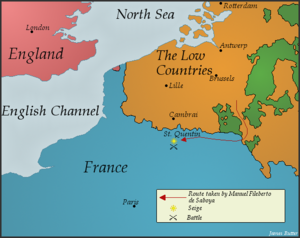Battle of St. Quentin (1557)
| Battle of St. Quentin | |||||||
|---|---|---|---|---|---|---|---|
| Part of the Habsburg-Valois War | |||||||
 Map of Manuel Fileberto de Saboya's Dutch campaign. | |||||||
| |||||||
| Belligerents | |||||||
|
Spain England | Frankreich | ||||||
| Commanders and leaders | |||||||
|
Duke of Savoy Lamoral of Egmont | Duke de Montmorency | ||||||
| Strength | |||||||
|
6,000 infantry 4,000 cavalry |
18,000 infantry 6,500 cavalry | ||||||
| Casualties and losses | |||||||
| 200 dead or wounded | 14,000 dead or wounded | ||||||
The Spanish won a significant victory over the French in the Battle of Saint-Quentin (1557) during the Franco-Habsburg War (1551–1559), which Philip II of Spain resumed having gained English support with Queen Mary as an ally.
The battle took place on the Feast Day of St. Lawrence (August 10 in the Julian Calendar; August 20 according to the Gregorian Calendar). At the Battle of St. Quentin the French forces under Constable de Montmorency were overwhelmed and Montmorency was captured by the Spanish forces under the command of the Duke Emmanuel Philibert of Savoy in an alliance with English troops, and the French were defeated.
After the victory over the French at St. Quentin, 'the sight of the battlefield gave [Philip] a permanent distaste for war', he declined to pursue his advantage, withdrawing to the Netherlands. The Treaty of Cateau-Cambresis ended the war. Being of a grave religious bent, Philip was aware that 10 August is the Feast of St Lawrence, a Roman deacon who was roasted on a gridiron for his Christian beliefs. Hence, in commemoration of the great victory on St Lawrence’s Day, Philip sent orders to Spain that a great palace in the shape of a gridiron should be built in the Guadarrama mountains northwest of Madrid. Known as El Escorial, it was finally completed in 1584.
The year 1557 began disastrously for the Catholic 'Bloody' Queen Mary and her husband Phillip of Spain who had brought England into his father's war against France, disregarding his marriage treaty by which England was meant to remain neutral even if Philip's other dominions were at war.
The English army under the Earl of Pembroke did not arrive in time for the battle, but played a significant role in the capture of the city that followed.
Pembroke was Mary's most effective commander at the battle of St Quentin, when he led the English contingent to victory that included among the officers such former reformists as Lord Bray, Sir Peter Carew, Sir Nicholas Throckmorton and the surviving sons of the duke of Northumberland; Ambrose and Lord Robert Dudley.
John Dudley, the son of Northumberland, had died not long after he left the Tower and his three surviving brothers were pardoned for their recorded treasons in January, 1555 and so duly served the Queen and King Philip on the St Quentin expedition, where Henry Dudley was killed and his remaining brothers won the restoration of their honour and titles.
The greatest impact of this battle, however, was not on France, England or Spain, but on Italy. Duke Emmanuel Philibert of Savoy, having won the victory, had also secured a place at the conference table when the terms of peace were deliberated. The duke was able to secure the independence of the Duchy of Savoy, which had been occupied by the French a generation earlier. As part of the peace terms, Emmanuel Philibert married Marguerite d’Angoulême, younger sister of King Henry II of France, in 1559. The Duke moved the capital across the Alps to Turin two years later, making Savoy an Italian state, and refounding the dynasty of the House of Savoy, which would become the royal house of a united Italy in 1860.
